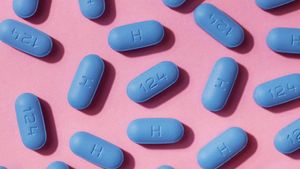Scroll queer TikTok and you’ll find thousands of clips tagged #sobergasm, filled with couples raving about mind-blowing sober sex, dancers dripping with post-club euphoria, and breath-work devotees describing trippy highs with zero substances involved.
After years of pandemic partying and “hangxiety,” a growing slice of LGBTQ+ folks are exploring pleasure minus the pour. They’re calling the peak sensations “sobergasms,” and insisting the rush rivals any boozy buzz.
So what exactly is happening when everything feels orgasmic, yet nothing stronger than sparkling water is in play? We asked three pros—sex educator Birna Gustafsson, pjur in-house sexologist Tim Lagman, and relationship expert Zachary Zane—to break down the trend.
What is a sobergasm, anyway?
“A sobergasm is a portmanteau of ‘sober’ and ‘orgasm,’ used to describe the more intense or heightened orgasms people can experience when they’re sober,” says Zane, noting that people within the queer communities often rely on drugs or alcohol to enhance their experience.
Lagman agrees, adding, “It’s that rush of pleasure, emotional intensity, or spiritual clarity that feels orgasmic, but it’s entirely sober. While it can happen during sex, it’s not limited to erotic moments.”
In terms of TikTok discourse, Gustafsson notes that it can mean a literal lights-out climax, a festival-floor natural high, or simply a “modern spin on ‘straight edge,’ but centered more on pleasure than abstinence.”
Your brain on a natural high

unguryanu/Shutterstock
During a sobergasm, “the body releases a cocktail of feel-good chemicals, including dopamine, serotonin, oxytocin, and endorphins,” Lagman explains. It’s the same neurochemical symphony behind orgasm or runner’s high, just triggered by breath, movement, or deep connection instead of alcohol.
Gustafsson adds that while no actual genital orgasm occurs in many cases, “feeling autonomy, confidence, release, and joy can mimic the rush of arousal.” In other words, the circuitry is there, but the switch is just flipped differently.
Why queer folks are swapping cocktails for clarity
Queer nightlife has long revolved around bars, clubs, and chemsex scenes, sometimes as a refuge, and others as an escape. But that’s shifting.
“Research shows that queer individuals tend to have higher rates of drug use and abuse compared to their straight counterparts,” Zane says, with the American Addiction Centers showing that LGBTQ+ adults are more than twice as likely to use illicit drugs and suffer from a substance use disorder as their straight counterparts. “It’s understandable that some might seek out substance-free euphoria as an alternative—especially in response to the often pervasive party and sex culture.”
Lagman sees the same pivot, noting post-pandemic introspection, rising wellness culture, and “a generational craving for authentic intensity.”
Meanwhile, Gustafsson’s college workshops are packed with students asking how alcohol affects consent and pleasure. “The idea of going out and having fun requires drinking is starting to grow old. As people feel more empowered to express their LGBTQ+ identities at a younger age than before, spaces that allow for connection for those under 21 set the tone for how they connect in later years.”
How to access a sobergasm
Experiencing a sobergasm for yourself may be difficult, especially if you’re more used to the traditional party scene of old. To try it on for yourself, Lagman rattles off the greatest hits:
- Sex with intention — think tantric breath, somatic focus, [lube], and eye contact that doesn’t blur.
- Music & dance — sober raves and ecstatic dance where the beat “drives a visceral high.”
- Breathwork & meditation — holotropic sessions or deep chanting that tip you into altered states.
- Nature & movement — hiking, swimming, pole dancing, even cold plunges.
- Authentic connection — vulnerability floods the brain with oxytocin, which bypasses the “need for artificial simulation.”
Zane adds therapy to the toolkit, as well. “It helps you explore the roots of why you might feel the need to drink to enjoy intimacy—what fears or shame are underlying those habits? Addressing these emotions can make sober sex more accessible and pleasurable,” he says.
Gustafsson’s also encourages people to practice flirting sober, which can be “incredibly empowering once you’ve done the work of regulating your emotions when facing rejection.”
Sex, sobriety & the myth that booze is better

KotoImages/Shutterstock
Despite marketing that pairs cocktails with confidence, alcohol can blunt sensation and stall orgasm.
“Alcohol and drugs can actually inhibit intimacy,” says Zane. “They can make it harder to be present, reach orgasm, or feel emotionally connected.”
Sobriety changes that emotional connection. Lagman describes partners taking their time and tuning into each other’s breath.
Gustafsson notes this challenges chemsex norms that equate queer pleasure with narcotics. “Sobergasms, as silly of a TikTok trend they may be, push back on this idea and show that you don’t need to rely on anything but yourself to feel good.”
Yes, sober sex can feel raw at first—no haze to hide behind—but many discover it’s like “having sex for the first time again, with full presence,” Lagman says.
Keeping sobergasms authentic (and hype-proof)
Wellness buzzwords, like many trends, come with a branding risk.
“There’s a risk of companies or influencers offering superficial or misleading advice, or trying to commodify this experience for profit,” Zane warns.
“Sobergasm could be turned into a hashtag to sell retreats,” Lagman echoes. “At its core, this concept is free. It’s DIY. It belongs to the people, not the marketers.”
Gustafsson is skeptical of “unregulated supplements” that promise instant ecstasy. “Most of these products rely onplacebo effects,” she says. “If something is telling you you’ll have great sex, the possibility of having great sex, and the permission to seek it out are enough to ignite desire.”
Bringing sobergasms to your sexual practice
Ultimately, reframing sobriety is about addition, not subtraction. Zane lists the gains: cash saved, deeper intimacy, no hangovers, sharper self-awareness. Lagman calls it “awakening.” Gustafsson sums it up:
“Sobriety isn’t about what you cut out of your life, it’s about what you get back.”
So whether your next mind-blowing moment happens mid-breathwork, on a sunrise hike, or naked in bed with nothing stronger than lube and trust, remember: the most powerful drug might already be coursing through your own queer, vibrant body. Drink it in—no chaser required.



























































 Peopleimages.com - Yuri A/Shutterstock
Peopleimages.com - Yuri A/Shutterstock
















